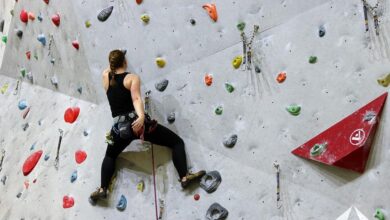Unleashing Your Full Potential: The Definitive Guide to Functional Training for Total Body Transformation

In today’s fast-paced world, achieving holistic health and wellness has become more crucial than ever. Functional training is an effective and versatile approach to fitness that can help you unleash your full potential. This comprehensive guide will delve into the principles, benefits, and best practices of functional training for an extraordinary total body transformation.
Understanding Functional Training
What is Functional Training?
Functional training involves exercises that mimic everyday movements to improve overall functional strength, stability, and mobility. Unlike traditional resistance training that focuses on isolated muscle groups, functional training incorporates multiple muscle groups simultaneously. This holistic approach to fitness ensures that your body works together, creating better balance, coordination, and strength.
The Principles of Functional Training
1. Multi-Directional Movement
Functional training emphasizes movements in all planes of motion – sagittal (forward/backward), frontal (side to side), and transverse (rotational). This multi-planar approach ensures a comprehensive workout, accommodating various actions you perform daily.
2. Compound Exercises
Exercises in functional training are typically compound movements, engaging multiple joints and muscle groups. This not only maximizes calorie burn but also improves overall coordination and muscle synergy.
3. Core Stability and Strength
A strong core is the foundation of functional training. Core stability and strength are essential for nearly every movement, from lifting groceries to getting out of bed. Functional exercises often emphasize core activation to enhance overall stability and power.
4. Balance and Coordination
Functional training challenges your balance and coordination, ensuring your body can control movements efficiently. Exercises like single-leg squats or stability ball workouts train your proprioception, making you more responsive and agile.
The Benefits of Functional Training
Enhanced Everyday Performance
Functional training prepares your body for real-life activities, from carrying heavy bags to playing with your kids. It improves your body’s efficiency, making daily tasks easier and reducing the risk of injury.
Improved Strength and Endurance
By engaging multiple muscle groups simultaneously, functional training builds overall strength and endurance. This results in a well-rounded physique that is not only strong but also capable of sustained effort.
Better Mobility and Flexibility
Functional exercises often involve full range-of-motion movements, contributing to better joint mobility and muscle flexibility. Enhanced mobility and flexibility reduce the risk of injury and improve overall functional health.
Boosted Metabolism
Compound movements in functional training are highly effective in burning calories and boosting metabolism. This metabolic enhancement facilitates fat loss and helps in achieving a leaner physique.
Reduced Risk of Injury
Functional training focuses on balance, coordination, and joint stability, reducing the likelihood of injuries. Strengthening stabilizer muscles around critical joints ensures a safer workout experience and a healthier body.
Key Functional Training Exercises
1. Squat to Press
Typical functional exercise that works the legs, core, and shoulders. Start with feet hip-width apart, holding dumbbells at shoulder height. Lower into a squat, then drive through the heels to stand up, pressing the weights overhead.
2. Deadlifts
Deadlifts target the posterior chain, core, and grip strength. Start with feet shoulder-width apart, barbell in front. Hinge at hips, lowering torso while keeping back flat. Grip the bar, engage core, and lift by extending the hips and standing straight.
3. Plank Variations
Planks build core strength and stability. Try the standard plank, side plank, or dynamic versions like plank jacks. Maintain a neutral spine and engage your core throughout these exercises.
4. Lunge Variations
Lunges work the lower body and enhance balance. Include forward, reverse, and lateral lunges to target different muscle groups and improve multi-planar stability.
5. Medicine Ball Slams
Excellent for building power and core strength. Stand with feet shoulder-width apart, lift a medicine ball overhead, and slam it forcefully onto the ground. Repeat with controlled movements.
6. Kettlebell Swings
Kettlebell swings enhance power and cardiovascular endurance. Stand feet hip-width apart, hold kettlebell with both hands. Hinge at hips, swing kettlebell between legs, then drive hips forward to swing the weight up to shoulder height.
Designing Your Functional Training Program
Assess Your Current Fitness Level
Before beginning any exercise regimen, assess your fitness level. Consider seeking advice from a fitness professional who can help design a customized program tailored to your goals.
Set Concrete Goals
Define clear and achievable fitness goals. Whether it’s enhancing everyday performance, building strength, or losing weight, having concrete goals will guide your training and keep you motivated.
Create a Balanced Routine
A well-rounded functional training program includes strength, cardiovascular, flexibility, and mobility components. Aim for a mix of the following:
- Strength Training: 2-3 days per week focusing on compound movements.
- Cardiovascular Training: 2-3 days per week with activities like HIIT, running, or cycling.
- Mobility & Flexibility Training: Incorporate yoga, stretching, or mobility drills to maintain flexibility and prevent injuries.
Progressive Overload
Gradually increase the intensity, weight, or complexity of your exercises to continue challenging your body. Progressive overload is crucial for ongoing improvements in strength and performance.
Recovery and Rest
Recovery is vital in any training program. Ensure you have 1-2 rest days per week and get adequate sleep and nutrition to support muscle repair and growth.
Example Functional Training Workout Plan
Day 1: Strength Training
- Squat to Press: 4 sets of 12 reps
- Deadlifts: 4 sets of 10 reps
- Plank Variations: 3 sets, 1 minute each
- Forward Lunges: 3 sets of 12 reps per leg
Day 2: Cardio & Core
- HIIT Workout (30 seconds on, 15 seconds off for 20 minutes)
- Burpees
- Kettlebell Swings
- Jump Squats
- Mountain Climbers
- HIIT Workout (30 seconds on, 15 seconds off for 20 minutes)
- Bicycle Crunches: 3 sets of 15 reps per side
- Side Planks: 3 sets, 30 seconds each side
Day 3: Mobility & Flexibility
- Dynamic Warm-Up (5-10 minutes)
- Yoga Flow focusing on Hip Openers (30 minutes)
- Foam Rolling and Stretching (20 minutes)
Day 4: Strength & Power
- Medicine Ball Slams: 3 sets of 15 reps
- Kettlebell Swings: 4 sets of 20 reps
- Bulgarian Split Squats: 3 sets of 12 reps per leg
- Russian Twists with Weight: 3 sets of 20 reps
Day 5: Active Recovery
- Light Jog or Walk (20-30 minutes)
- Gentle Yoga or Stretching (30 minutes)
Ideal for YogaNutrition for Functional Training
Prioritize Whole Foods
Consume a diet rich in whole foods, including lean proteins, complex carbohydrates, healthy fats, and an abundance of fruits and vegetables.
Hydration
Stay well-hydrated, as adequate fluid intake is essential for optimal performance and recovery.
Pre- and Post-Workout Nutrition
- Pre-Workout: Eat a balanced meal or snack 1-2 hours before training. Include carbohydrates for energy and protein for muscle repair.
Ideal for pre-workout
- Post-Workout: Consume a meal or snack containing protein and carbohydrates within 30 minutes after exercising to support recovery and muscle growth.
Ideal for post-workout
Supplementation
Consider supplements like whey protein, creatine, or BCAAs if you need additional support to meet your fitness goals. Always consult a healthcare professional before starting any supplementation.
Recommended Protein
Conclusion
Functional training is a dynamic and effective approach to total body transformation. By focusing on multi-directional movements, compound exercises, and core stability, you can enhance everyday performance, build strength, improve mobility, and reduce the risk of injury. With a well-designed program and proper nutrition, you can unleash your full potential and achieve your fitness goals. Integrate functional training into your routine and witness a remarkable transformation in your body and overall health.




